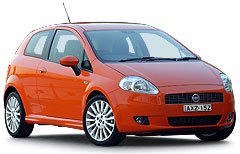New Alfasud gets legs
BY BYRON MATHIOUDAKIS | 9th Oct 2006

Speculation is mounting that a concept car may be unveiled as early as next March at the Geneva motor show.
Like the original, the production version of the Alfasud – due in 2008 – will be front-wheel drive.
It will be based on the platform of the new Punto, which is also shared with the 2007 Opel Corsa.
However, in order to maintain the original Alfasud’s cherished steering and handling capabilities, Alfa Romeo is thought to be hard at work honing the chassis for a much sportier feel.
The next version of the popular-in-Europe Lancia Ypsilon may also be spawned off the Alfasud program.
The engine room should include the Punto’s 1.4-litre petrol and 1.2-litre and 1.9-litre turbo-diesel powerplant options, with a larger 1.6-litre petrol unit also expected to become available.
To make room for the new Alfasud (as well as help close the gaping hole between it and the new 159), the successor to today’s six-year old 147 range is expected to grow considerably larger.
This car, to be called the 149, will be based on the running gear of the new Fiat Brava, due in Australia in the second half of next year.
The Alfasud may lead Alfa Romeo’s return to the United States.
The Italians, spurred on by the overwhelming success of the New Mini over there, want a piece of that American sales pie.

In the Mini’s first three years over 150,000 were sold Stateside, compared to a forecast of 60,000.
To that end, the new Alfasud will eschew the original’s comely two and four-door two-box design (a proper rear hatch didn’t appear until late in the Alfasud’s life, in 1982) for a sleek, almost coupe-like appearance.
Ironically, the first Alfasud was Alfa Romeo’s attempt at emulating the east-west front-wheel drive formula created by the original Mini.
The Milanese company, which was independent of archrival Fiat back then, commissioned ItalDesign’s Giorgetto Giugiaro to pen an efficient and affordable compact family car.
‘Alfasud’ translates to "Alfa South", and is a reference to it being Alfa Romeo’s first model to be made at the then-new Pomigliano d'Arco factory near Naples, in southern Italy – mostly at the Italian government’s insistence.
Boasting a flat-four boxer engine of 1.2-litre capacity, it debuted in four-door guise at the Turin motor show in 1971, with the evocative two-door Ti (Tourismo Internazionale) models arriving in 1973.
A two-door wagon, called Giardinetta, was also available from 1975, while a swoopy coupe (ironically a three-door hatchback) called the Alfasud Sprint broke cover during 1976.
Australian Alfasud sales commenced in early 1974, and over the years gained a 1.5-litre engine, as well as a five-speed manual gearbox.
Alfa Romeo replaced the Alfasud with the 33 in 1984. However, while much of the old car’s platform was utilised, the angular 33 failed to capture its predecessor’s charm.
Whether the Alfasud name is utilised on the new Alfa Romeo light car remains to be seen.
Although loved by critics and driving enthusiasts alike, the original also became a byword for rust.
Images of nearly new examples corroding before the eyes of astonished owners became folklore, and contributed greatly to Italian cars gaining notoriety for virtually dissolving away.
Fiats, Lancias and Alfa Romeos of the time were reportedly made using cheap Russian steel, as a result of an automotive technology deal with the former Soviet Union that begat cars like the Fiat 124-based Lada.